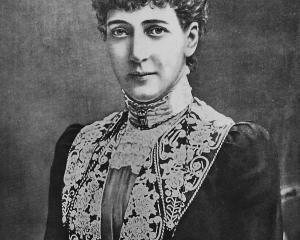"For quite a number of years, when these birds were here, a flock of them roosted on the ridge of a shed belonging to me. Since it has been removed I believe they have taken to some dry trees further down the bay.
"Two species of these birds generally come together; one is not unlike the english sand martin, but the other is larger, with white markings. Sometimes there comes with these birds a large species of fly-catcher. In colour it is bluish black. It is somewhat larger than a starling.
"This bird takes possession of a tree stump, from which it makes its dart for flies, and it always returns to the same perch."
Mr Robertson adds: "Can you name for me a large yellow butterfly, which, so far as I am able to say, has been observed here only within the last three years, and, so far, I have only been able to see seven specimens in that time.
"It is very difficult to get a good view of this flying, as it is a high flyer, and, seemingly lives in the tree-tops, the kamahi for preference.
"However, I managed to get within perhaps 12 feet of one last January, and I judged the spread of wing to be nearly three inches.
"The body is of a dark amber, whilst the upper surfaces of the wings are bright yellow, latticed with dark lines in a diamond pattern.
"I am not quite sure as to the markings on the under-sides, but they are shades of yellow and green.
"Altogether, it is the handsomest butterfly I have yet seen in the Dominion."
• Not only are "possums a source of loss to settlers in the Catlins and Orepuki districts, but during a recent visit to Paradise I found that there also they have become a nuisance.
"The beech forests on Mount Alfred and in the Routeburn direction must be teeming with them.
"At Aitken's, my charming temporary home at Paradise, I was disturbed every night by the beasts scampering over the roof, and was told that they destroy fruit, flowers, and vegetables - just as they do in Tasmania.
"The department should declare an open season of, say, three months - June, July, and August, when the winter fur is at its best - and charge a fee of, say, 1 for taking any number by any means (you cannot shoot many in our native bush, which is not open like the gumtree forests of the Commonwealth).
"The license should carry the right to sell.
"To bar selling is ridiculous when the animals are so numerous, and it does not prevent trading in the skins." - I am, etc., I.R.
• Information has been made public through this column that, although vast flocks of godwits leave New Zealand for northern countries every year about April, a number always remain behind, to pick up the migratory route, probably, in the following year.
The presence of birds that missed this year's migration is commented upon by Mr A. B. Morton, who writes from Papamoa, Te Puke, in the Bay of Plenty, and who saw a large number of godwits at Kati Kati, a settlement in Tauranga harbour, in the second week in June. - ODT, 14.7.1912












